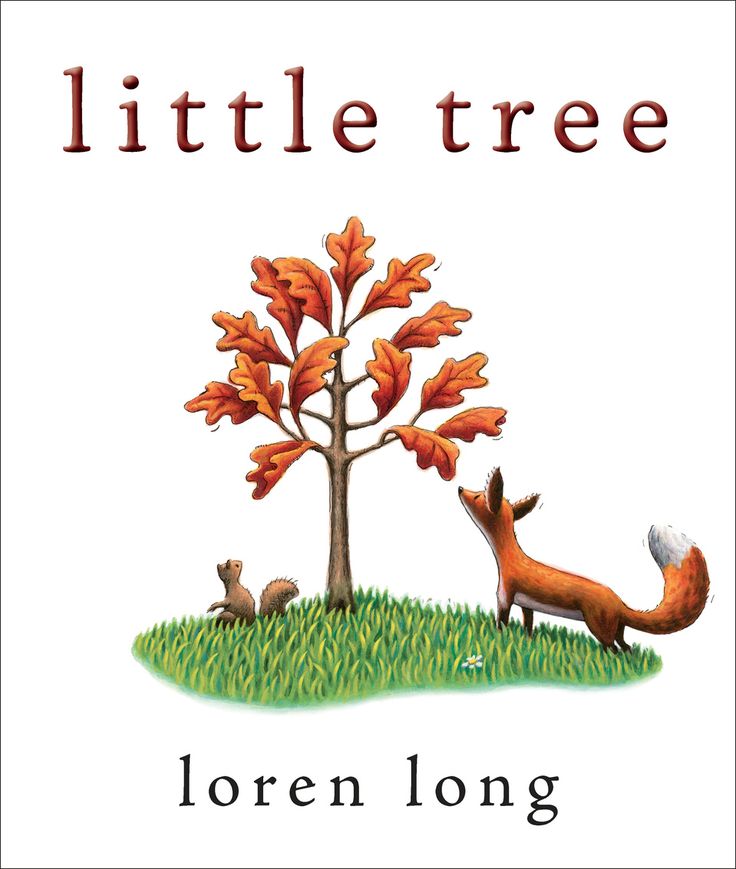Loren Long’s Little Tree uses the fall season to highlight the temptation we often have to “hold on” and resist change rather than “letting go” and surrendering to the rhythm of the seasons. While many other picture books focus on this same theme, Little Tree—for its readability, its simplicity, its sweetness, and especially the lovely and endearing illustrations—is so far my favorite.
Little Tree is just like the other little trees that surround him: he is covered in leaves and the forest animals play and sing in his branches. But when autumn comes, Little Tree is hesitant to drop his leaves—so he doesn’t. Spring comes, and the other trees have grown taller and filled their branches with fresh, new, green leaves. As the seasons continue to change, and the trees around Little Tree continue to grow, the forest animals ask Little Tree why he hasn’t dropped his leaves. Soon, like the rest of the forest, they too leave Little Tree alone and move on. One summer, Little Tree cannot feel the warmth of the sunlight anymore. He looks around, looks up, and sees the trees that used to be his size towering over his head. Finally, he decides to let go of his leaves. At first, Little Tree feels naked and cold without his leaves. But as the seasons pass, and as he submits to the natural rhythms of loss and gain, he begins to change and grow.
. . . as the seasons pass, and as Little Tree submits to the natural rhythms of loss and gain, he begins to change and grow.
Design: 5/5
I love the softness and roundness of Long’s drawings and the brightness and richness of his colors. His playful depictions of trees and animals make the world and its creatures seem warmer and kinder. One of the most enjoyable parts of reading this book is watching the squirrels, birds, racoons, and deer as they dart and scamper over each page. Parents may also enjoy helping their children identity the different kinds of trees by their varying leaf-shapes.
Style: 4.5/5
Long’s prose is simple and to the point. No words are wasted, and the prose is not forced or contrived. Easy-to-comprehend, shorter lines are interspersed with longer ones. Long effectively utilizes repetition without rendering the repeated phrases dull: “the mourning dove’s flutey song” and “Little Tree just hugged his leaves tight.”
Content: 4.5/5
This story teaches us that fear can keep us from growth, and that without growth, we miss out on life, relationships, and reality. Embracing growth can be painful—and it’s always a process—but it leads us to be more in touch with ourselves, others, and our surroundings, and we become stronger and more beautiful as a result.
I have been in a season of considering the word yield, and as I do, pondering seeds, plants, and trees in our world and in the Bible, and pondering what they can teach us about the process of “letting go” and growing. I hope to write more on this topic soon, but for now, here are some lessons I have been pondering from Little Tree:
Sometimes we have to let things go not because they are bad, but because their season is over. “In the heat of long summer days, Little Tree’s leaves kept him cool.” The leaves served a purpose in their season.
Loss is not unique to one person—all the trees lost their leaves.
Resisting change can lead to isolation from others and the world around us. The forest creatures who used to play and sing in Little Tree’s branches stop visiting him and questioning his lack of growth. They all begin to leave Little Tree alone. He begins to loose touch with reality, with life: “One summer, Little Tree could no longer feel the sunlight. The squirrels played high above on the broad, tall trees. And the mourning dove sang so far away that he could hardly hear her flutey song.”
There is a cost to growth:
Growth can feel painful. When we let go of what was, we feel what is—and sometimes that hurts. “As his last leaf floated to the ground, for the first time Little Tree felt the harsh cold of winter.”
Growth takes time and patience; it is an ongoing process. Little Tree doesn’t immediately grow new leaves on his bare branches, nor does he immediately become as tall as the trees around him. “But in time,” the book says, “something happened.” And though the book doesn’t continue to follow Little Tree through the subsequent seasons, we can be sure that he needed to drop his leaves each Fall in order to grow new ones each Spring. In other words, the growing process was never over—it was continual, cyclical.
We are in charge of our own growth process. No one else can do the dropping and growing for us. The animals question, cajole, and cheer Little Tree on to drop his leaves. ‘“You can do it,” a fox tells Little Tree. ‘“Ready? One, two . . .’” A squirrel makes Little Tree feel almost obligated to grow: “You’re supposed to drop your leaves now,” he says. And so this leads us to another point:
Desire—not obligation, or the convictions of others—leads to change.
Desire—not obligation, or the convictions of others—leads to change. Of course, seeing the growth of the trees around Little Tree, and how he is being left alone, motivates him to grow, but he still must make the decision to let go for himself.
Overall: 14/15

